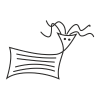Thanks for the input. To divulge a few more details about my project, I'm operating on a hexagonal grid, and (melee) units will engage in combat automatically if they enter the same tile. My intention was for the game to be a bit less 'chess rigid' in terms of rules and to allow for combat behaviour that is a little more emergent and less predictable in nature. Combat nature will indeed play an important role in which costing technique I elect to use.
Units will still have fairly short movement ranges (perhaps three to five movement 'points'), and can be ordered to traverse a series of tiles. Combat occurs when two melee units occupy the same tile, and the nature of that combat will be dependent on the facing of those units; units may be moving directly towards one another* resulting in a normal combat engagement with a defined win / loss condition (loss resulting in the losing unit being forced backwards to an appropriate tile and the victor remaining on that tile), however units moving past one another** will instead skirmish, lose one or more movement points in the resulting combat, and otherwise continue their movement if capable. This allows for weaker units to hinder the movement of stronger units, as well as otherwise faster, lighter units gaining the ability to harass and disassemble slower, heavier units. It also adds additional elements of unpredictability in the player decision making process, with the option of making slow and reliable progress, or taking the risk of being disrupted by the enemy and moving more quickly. This is a simplified example, as there are other orientations units can approach one another from with differing results; I want to make position and facing of units important, unlike games like Civilization / Advance Wars, where facing plays no role at all.
*Unit A enters from clock-face 12 moving to 6, unit B enters from clock-face 6 moving to 12.
**Unit A enters from clock face 2 moving to 10, unit B enters from clock-face 8 moving to 4.
Whether movement cost is taken into account before or after movement can potentially have a radical effect on the outcome of these combats, particularly when units skirmish. If the cost is on exiting a tile, skirmishing units could be forced into a normal combat engagement as they are unable to move further, and this could be used to determine a more punishing result (exhaustion leading to poorer combat performance). Alternatively, this could be tied up neatly by costing on entry, meaning units can always pass one another and bypassing the situation where units get stuck on the same tile.
Finally, I have also considered costing on both entry and exit. This is good for tiles that represent certain terrain types - for example it is more difficult to climb up a hill than it is to move down it, ergo it could cost 2 points to move onto the hill, but only 1 point to move down it. You'd obviously want to adjust how many movement points a unit has to reflect this key difference.
I'm currently leaning towards the third consideration, as it allows for the exhaustion rule to come into effect, and defines movement on a more tactical basis, which I find desirable. I'm worried this may appear overly complicated in conjunction with combat rules, but I don't think it's too difficult for players to pick up, and unlike games like Civilization, combat is the essence of this game, with much less emphasis on the long term strategy and development side of gameplay.
Thoughts?












